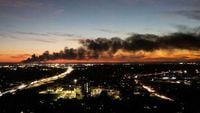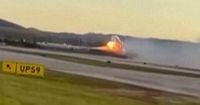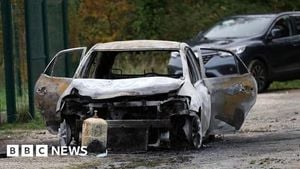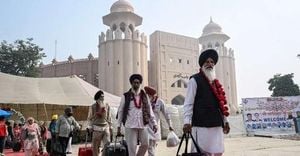On the evening of November 5, 2025, the city of Louisville, Kentucky was rocked by a catastrophic event that sent shockwaves far beyond its borders. A UPS cargo plane, a McDonnell Douglas MD-11 built in 1991 and recently converted for freight, crashed shortly after takeoff from UPS Worldport, the company’s global aviation hub, killing at least 12 people and injuring 11 others, according to the Associated Press and BBC. The disaster has left a community grieving, investigators searching for answers, and families desperate for news of missing loved ones.
It was just after 5:15 p.m. local time when UPS flight 2976, bound for Honolulu with three crew members and a massive load of up to 20,000 packages and 255,000 pounds of jet fuel, began its takeoff roll at Louisville Muhammad Ali International Airport. But as the aircraft gathered speed, disaster struck. Todd Inman of the National Transportation Safety Board (NTSB) told reporters that airport security footage captured a large fire erupting on the left wing. Moments later, the left engine detached from the wing, an event that Inman described as visible on the security video. "There are a lot of different parts of this airplane in a lot of different places," Inman said, noting the debris field stretched for half a mile.
Despite the rapidly developing emergency, the MD-11 managed to clear the airport fence at the end of the runway. But it could not maintain flight. The plane skidded off the runway, struck nearby businesses—including Kentucky Petroleum Recycling and Grade A Auto Parts—and exploded in a massive fireball. The inferno quickly spread to other buildings, causing secondary explosions and prompting a major emergency response. The flames, fueled by the plane’s 38,000 gallons (144,000 liters) of jet fuel, created a dangerous situation for first responders and residents alike. Louisville Fire Department chief Brian O'Neal described the scene as "very dangerous" due to the sheer volume of fuel spilled at the site.
As the fire raged, emergency crews rushed to contain the blaze and search for survivors. Kentucky Governor Andy Beshear acknowledged the devastation, saying, "We do not expect to find anyone else alive," and predicted the death toll could rise as searches continued. The crash claimed the lives of at least 12 people, including a child who was at the auto parts business with a parent. Eleven others were hospitalized, two of them in critical condition in the University of Louisville Hospital burn unit. Eighteen people were treated and discharged from local hospitals, but the number of unaccounted-for individuals left families in agony. As of Wednesday, 16 families had reported missing loved ones, according to BBC.
Nearby residents were ordered to shelter in place, first within a five-mile radius and later reduced to one mile, as concerns about further explosions and air pollution mounted. The airport, located just seven miles from downtown Louisville and surrounded by residential neighborhoods and business districts, halted all operations in the immediate aftermath. Flights resumed the following day, but the sense of shock lingered.
The crash site was a scene of utter devastation. The debris field stretched across half a mile, with parts of the aircraft scattered among the wreckage of businesses and industrial sites. Investigators quickly prioritized securing the left engine, which had detached during takeoff and was found just off the runway, as well as recovering the cockpit voice and data recorders—the so-called "black boxes"—from the tail of the aircraft. Despite suffering heat exposure, Inman expressed confidence that the recorders would yield valuable information once examined at the NTSB lab in Washington, D.C. "We feel comfortable once we get these to our lab in D.C. that we will be able to get a good readout of the applicable data," he said.
Determining the cause of the crash is now the top priority for federal investigators. The dramatic video footage and the black boxes are expected to provide crucial insights. CBS News aviation safety analyst Robert Sumwalt, a former NTSB chair, explained that investigators would look at the maintenance and inspection history of the aircraft, as well as the training records of the crew. The MD-11 is designed to take off with one engine out, but losing two engines—one to fire and separation, and the second possibly damaged or inoperative—while approaching 200 mph left the pilots with an impossible situation. The loss of the left engine would also have altered the weight and balance of the aircraft, making stable flight nearly impossible, especially with a full load of fuel and cargo.
The crash had a devastating ripple effect on the surrounding community. The fire spread to Kentucky Petroleum Recycling and Grade A Auto Parts, causing smaller explosions and damaging property. Governor Beshear noted it was a "blessing" that the plane did not strike the nearby Ford Motor factory or the convention center, which could have resulted in even greater loss of life. Louisville Metro Council member Betsy Ruhe reflected the community’s sense of connection: "We all know somebody who works at UPS." The Worldport facility is the company’s largest, employing more than 20,000 people, handling 300 flights daily, and sorting over 400,000 packages per hour.
As the search for victims continued, stories of survival and loss emerged. Eric Richardson waited anxiously outside a police training academy for news of his girlfriend, who had been at a metal recycling business near the explosion and was not answering her phone. Stooges Bar and Grill, just 100 yards from the crash site, was shaken by the explosions. Bartender Kyla Kenady recalled, "I saw a plane in the sky coming down over top of our volleyball courts in flames. In that moment, I panicked. I turned around, ran through the bar screaming, telling everyone that a plane was crashing." Manager Lynn Cason added, "God was definitely with us," as no one at the bar was injured despite the proximity to the disaster.
In the aftermath, the Team Kentucky Emergency Relief Fund began accepting donations to help families with funeral expenses and other hardships. "In Kentucky, we grieve together and we support one another," Governor Beshear said, underscoring the state’s tradition of coming together in times of tragedy. Meanwhile, the investigation continues, with the NTSB and other authorities sifting through the wreckage and data to piece together the sequence of events that led to one of the deadliest aviation accidents in recent Kentucky history.
For Louisville and the UPS community, the scars of November 5 will not soon fade. But as the city mourns, it also demonstrates remarkable resilience, determined to support those affected and to seek answers, hoping that lessons learned from this tragedy will help prevent similar disasters in the future.





